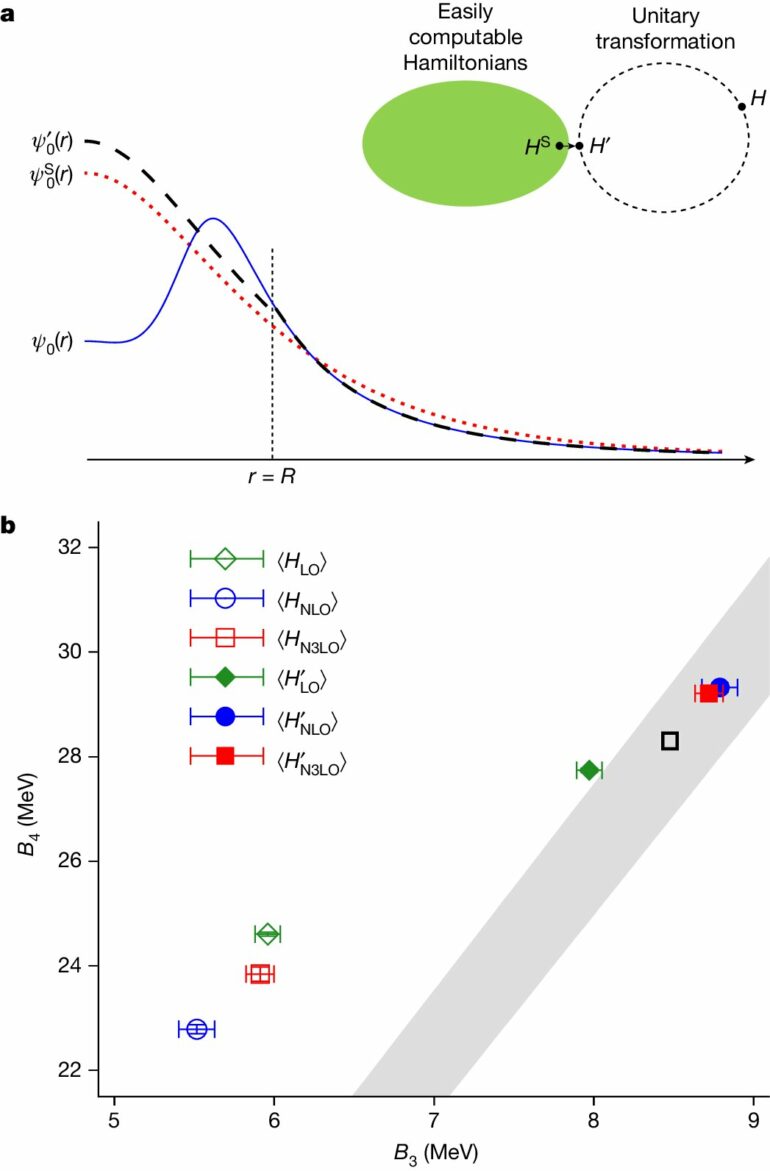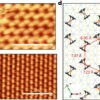Strongly interacting systems play an important role in quantum physics and quantum chemistry. Stochastic methods such as Monte Carlo simulations are a proven method for investigating such systems. However, these methods reach their limits when so-called sign oscillations occur.
This problem has now been solved by an international team of researchers from Germany, Turkey, the U.S., China, South Korea and France using the new method of wavefunction matching. As an example, the masses and radii of all nuclei up to mass number 50 were calculated using this method. The results agree with the measurements, the researchers now report in the journal Nature.
All matter on Earth consists of tiny particles known as atoms. Each atom contains even smaller particles: protons, neutrons and electrons. Each of these particles follows the rules of quantum mechanics. Quantum mechanics forms the basis of quantum many-body theory, which describes systems with many particles, such as atomic nuclei.
One class of methods used by nuclear physicists to study atomic nuclei is the ab initio approach. It describes complex systems by starting from a description of their elementary components and their interactions. In the case of nuclear physics, the elementary components are protons and neutrons. Some key questions that ab initio calculations can help answer are the binding energies and properties of atomic nuclei and the link between nuclear structure and the underlying interactions between protons and neutrons.
However, these ab initio methods have difficulties in performing reliable calculations for systems with complex interactions. One of these methods is quantum Monte Carlo simulations. Here, quantities are calculated using random or stochastic processes.
Although quantum Monte Carlo simulations can be efficient and powerful, they have a significant weakness: the sign problem. It arises in processes with positive and negative weights, which cancel each other. This cancellation leads to inaccurate final predictions.
A new approach, known as wavefunction matching, is intended to help solve such calculation problems for ab initio methods.
“This problem is solved by the new method of wavefunction matching by mapping the complicated problem in a first approximation to a simple model system that does not have such sign oscillations and then treating the differences in perturbation theory,” says Prof. Ulf-G. Meißner from the Helmholtz Institute for Radiation and Nuclear Physics at the University of Bonn and from the Institute of Nuclear Physics and the Center for Advanced Simulation and Analytics at Forschungszentrum Jülich.
“As an example, the masses and radii of all nuclei up to mass number 50 were calculated—and the results agree with the measurements,” reports Meißner, who is also a member of the Transdisciplinary Research Areas “Modeling” and “Matter” at the University of Bonn.
“In quantum many-body theory, we are often faced with the situation that we can perform calculations using a simple approximate interaction, but realistic high-fidelity interactions cause severe computational problems,” says Dean Lee, Professor of Physics from the Facility for Rare Istope Beams and Department of Physics and Astronomy (FRIB) at Michigan State University and head of the Department of Theoretical Nuclear Sciences.
Wavefunction matching solves this problem by removing the short-distance part of the high-fidelity interaction and replacing it with the short-distance part of an easily calculable interaction. This transformation is done in a way that preserves all the important properties of the original realistic interaction.
Since the new wavefunctions are similar to those of the easily computable interaction, the researchers can now perform calculations with the easily computable interaction and apply a standard procedure for handling small corrections—called perturbation theory.
The research team applied this new method to lattice quantum Monte Carlo simulations for light nuclei, medium-mass nuclei, neutron matter and nuclear matter. Using precise ab initio calculations, the results closely matched real-world data on nuclear properties such as size, structure and binding energy. Calculations that were once impossible due to the sign problem can now be performed with wavefunction matching.
While the research team focused exclusively on quantum Monte Carlo simulations, wavefunction matching should be useful for many different ab initio approaches. “This method can be used in both classical computing and quantum computing, for example, to better predict the properties of so-called topological materials, which are important for quantum computing,” says Meißner.
The first author is Prof. Dr. Serdar Elhatisari, who worked for two years as a Fellow in Prof. Meißner’s ERC Advanced Grant EXOTIC. According to Meißner, a large part of the work was carried out during this time. Part of the computing time on supercomputers at Forschungszentrum Jülich was provided by the IAS-4 institute, which Meißner heads.
More information:
Serdar Elhatisari et al, Wavefunction matching for solving quantum many-body problems, Nature (2024). DOI: 10.1038/s41586-024-07422-z
Provided by
University of Bonn
Citation:
New method of wavefunction matching helps solve quantum many-body problems (2024, May 15)



